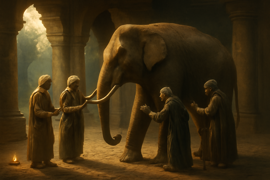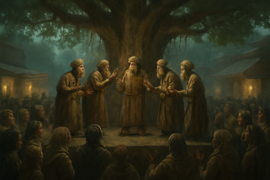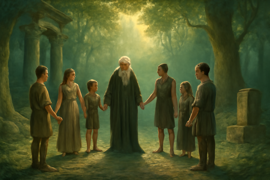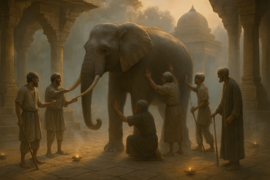Introduction
In the earliest dawn of human memory, long before steel and steam reshaped landscapes, a grand temple rose at the edge of a sprawling forest in ancient India. Its sandstone walls, etched with stories of gods and mortals, glowed with the first rays of sunrise. Worshippers drifted through carved pillars as incense curled skyward, carrying chants that echoed in shadowed corners. Nearby, six blind men—travelers from distant villages—gathered outside the temple gate. Each had heard of a majestic creature kept within; rumors called it an elephant, a beast whispered to embody strength, mystery, and divinity. Their curiosity outweighed caution, and despite their blindness, each man approached, guided by the hushed wings of faith and rumor.
One by one, they felt the creature’s vast form. One pressed his hand against a smooth, curving tusk, proclaiming it long and sharp like a spear. Another ran fingers along the great trunk, declaring it a massive snake. A third man grasped a broad, flapping ear, insisting it must be a fan carried by the wind. A fourth seized a sturdy leg and spoke of a solid column that held up the heavens. The fifth man tugged at a swishing tail and concluded it must be a rope, while the last felt the wide, leathery flank and was certain this creature was a wall. Each description rang with conviction, yet contradicted the rest.
Their voices rose like thunder over the courtyard. “You know nothing of truth,” one cried. “Your part is not the whole,” another snapped back. The onlookers, drawn by the commotion, formed a ring of murmuring spectators. The tension thickened like the summer haze. How could each man be so certain, yet so divergent? In this moment of discord, a small child—her sight keen and heart open—watched in growing concern. She had listened to the stories of the elephant’s grandeur and respected each man’s attempt to know it. But when disagreement descended into argument, she realized that true understanding required more than one perspective.
Under the crimson arch of the rising sun, the child stepped forward. With a gentle voice that cut through the arguments, she invited the men to pause. “Each of you touched only one part,” she said. “No one has felt the whole. Let us walk around in unity, combining what we know, and see the elephant together.” Their pride bristled at first, but the earnest calm in her tone eased their hearts. Slowly, they took her hand, forming a circle around the elephant. As they moved, each moment brought a new touch, another clue to understand the creature’s true form. The elephant’s greatness could not be captured by a single touch, but through many.
By the time the sun climbed high overhead, the men stood humbled, their eyes—though sightless—alight with shared insight. The temple’s silent grandeur and the forest’s distant murmur bore witness to their newfound wisdom: that no single truth can stand alone, and only through compassion, listening, and collaboration can humanity glimpse the full face of reality. In the heart of ancient India, the parable of the blind men and the elephant lived on, teaching every generation the enduring lesson of perspective and unity.
The Encounter: Fragments of Truth
The courtyard fell silent as the six blind men advanced toward the gentle giant tethered before them. Each step was guided by instinct and whispered expectation. Moorthy, the first traveler, felt the ivory curvature of a tusk and marveled at its cool hardness. “This creature must be sharp at its head,” he declared. Temur, the second, gripped the long, muscular trunk and recoiled. “Nay,” he said, “it winds like a great serpent.” Meanwhile, Ashok pressed his hand flat against an expansive ear, its edge flapping in the morning breeze. “A massive, living fan,” he insisted, “swaying with the wind.”

At once, Barun’s fingers encircled a column-like leg. “It’s a tree trunk,” he bellowed, “firm and unyielding.” Hari grasped a slender tail, coarse like braided rope, concluding immediately that this mysterious animal served as a living tether. And Kavita, placing her palm upon the vast side, felt leathery skin that rose and receded with each breath. “Surely,” she proclaimed, “this is a wall protecting the world.” Their statements clashed like cymbals, each man convinced of his own grasp of truth.
Voices escalated into disputes. Moorthy accused Temur of folly; Temur called Kavita blind to reality. Each retort seemed only to intensify the rift. The onlookers gathered, murmuring in confusion: how could such earnest witnesses disagree so fiercely? Some backed Moorthy’s tusk theory; others sided with the rope-tail. The temple priests exchanged worried glances. Even the elephant, ancient and patient, swayed gently, unperturbed by the human ruckus.
In the midst of heated debate, the little girl—eyes bright with compassion—stepped forward to speak truth to frustration. She reminded them that while each man touched a real part, none had felt them all. With careful politeness, she guided each blind man to share his perception in turn, then invited them to circumnavigate the elephant as a group.
Reluctance melted before her sincerity. They formed a single line, hands linked, moving slowly around the creature. At each turn, they felt a new facet: the warmth of its hide, the strength of its limbs, the gentle rumble when it breathed. As senses combined, their fragmented truths wove into understanding. The elephant was neither a serpent, nor wall, nor fan—but all at once a living tapestry of power, grace, and majesty.
By the time the circle closed, the blind men stood transformed. Their arguments gave way to astonished silence, followed by quiet laughter and tears of wonder. What had begun as six separate tales of an elephant ended as a unified revelation. They bowed their heads in gratitude to each other, to the child who led them, and to the lesson they had learned: that only by sharing perspectives can we perceive the whole.
Discord and Debate: Clashing Perspectives
The harmony found in their collective walk was fleeting. Soon after, the blind men dispersed to villages nearby, each eager to relate his version of the elephant. Word spread swiftly, and soon travelers from distant towns came seeking the beast. At the temple gate, Moorthy proclaimed it a sharp, piercing spear; Temur described a sinuous, living python; Ashok murmured of a vast, flapping fan; Barun spoke of a mighty pillar; Hari told of a coarse rope; and Kavita argued for an impenetrable wall. Each retelling grew more elaborate, embellished by memory, ego, and hearsay.

Wordsmiths and poets joined the fray, mounting arguments in verse and prose. Some posited that the elephant’s hidden mystery proved the supremacy of individual insight. Others declared that only those who truly sought wisdom could glimpse the whole. Debates raged in market squares, temple halls, and palace courts. Religious leaders quoted sacred texts; philosophers cited logic; travelers recounted firsthand accounts. Yet for every voice that rose, another challenged it, and the noise swelled like storm clouds gathering over the horizon.
In a bustling bazaar beneath a banyan tree, the blind men reunited for a public debate. Crowds pressed close: merchants, students, beggars, and scholars all thirsted for clarity. Six ornate chairs formed a semicircle at the tree’s base, and the men took their seats. A priest, chosen as moderator, asked each to speak in turn. Their words, once humble and curious, now carried pride and performative flourish.
Moorthy spoke first, weaving a tale of ivory teeth that could fend off any foe. Temur followed, describing the elephant’s trunk as a writhing serpent that guarded hidden truths. Ashok’s oratory painted the ear as a divine canopy that sheltered souls. Barun extolled the leg’s steadfast strength. Hari sang of the tail’s subtle guidance, like fate’s invisible tether. Kavita declaimed the side as the fortress of existence itself. As each voice rose and fell, the audience cheered, jeered, and swapped animated gossip.
The debate escalated. Voices clashed with inscrutable passion. When Fahim, a wandering scholar, rose to propose that perhaps no single account was complete, he was met with derision. “Your doubt undermines the certainty we cherish,” one argued. Another retorted, “Without certainty, wisdom crumbles.” The tussle threatened to turn violent until an elderly monk stepped forward. “Stop,” he said with a voice aged by calm reflection. “What do we seek? Victory in argument, or true understanding?”
A hush fell over the crowd. The monk spoke of the little girl who had once led six blind men around the elephant, teaching them that unity of insight revealed truth. His simple reminder cracked the foundation of conflict. From the silence, a new question emerged: could the power of diverse perspectives unite rather than divide? The debate dissolved not in defeat, but in a shared curiosity. Slowly, the crowd gathered closer, not in judgment, but in wonder.
At that moment, the blind men felt again the first stirrings of humility. They recalled the child’s gentle guidance, and the harmony born of collective touch. Their certainty softened, replaced by a deep hunger to understand beyond their own fragment. And though words alone might never capture the elephant’s full majesty, they recognized that listening to others was the path forward. The bazaar, once alive with discord, quieted into a space of respectful dialogue. Under the banyan’s ancient boughs, the parable rekindled its timeless promise: that only together can we approach the heart of truth.
Unity in Understanding: Beyond the Blindfold
In the aftermath of the bazaar debate, the blind men felt that something essential had shifted within them. Alone again, they reflected on the monk’s words: what is true understanding but the willingness to blend knowledge with compassion? Each man embarked on a quiet pilgrimage to revisit the elephant, but this time without pride or pretense. They entered the temple together at first light, greeting the great creature with reverent silence.

Moorthy reached for the trunk and felt its subtle nuance: warm, textured, and gently surveying the space. Temur followed, anchoring his hand upon the tusk to sense its lethal elegance and protective strength. Ashok listened as the flap of the ear whispered like silk in the breeze. Barun steadied himself against a leg, finding in its sturdiness a reflection of life’s unwavering pillars. Hari brushed the tail, noting how delicate yet vital its balance could be. Kavita leaned into the side, feeling the elephant’s heartbeat tremble through its hide, a steady pulse connecting all its parts.
Words fell away. In their place, each man sensed the elephant as a unified being—powerful yet gentle, vast yet perceptive. They inhaled the scent of earth and age and heard the faint rumble of breath beneath their palms. In this shared moment, the barrier between individual perception and collective reality dissolved. No single man held the whole truth; together, they did.
Reinvigorated, they emerged from the temple to find the little girl waiting beneath a blossoming tamarind tree. She greeted them with a quiet smile, as though she had known all along that they would return. They knelt, offering words of gratitude, each acknowledging how incomplete their earlier views had been.
The girl raised a hand and invited them to join her in the forest beyond the temple walls. There, among towering banyans, she led them to a clearing where villagers, merchants, travelers, and pilgrims had gathered. Word of the blind men’s transformation had spread, inspiring all who heard to reflect on their own biases and blind spots.
Under dappled sunlight, the blind men shared their story openly. They spoke not as conquerors of truth, but as humble seekers. Their tale wove together the greatest lessons of empathy, listening, and unity. Tears glistened in many eyes, for each listener sensed the universal echo in their own heart: that each of us, in our way, is blind to parts of reality we cannot touch or see.
When the final echoes of their voices faded, the crowd formed a living circle around the clearing—elders, children, strangers, and friends. Hands joined, not in debate, but in solidarity. In the hush that followed, the forest seemed to breathe around them in agreement. And in that sacred moment, the simple parable of the blind men and the elephant transcended time, place, and single perspective, showing all who listened that unity and shared insight shine brighter than the narrow light of certainty.
Conclusion
And so, the parable of the blind men and the elephant endures through centuries, retold around hearth fires and within temple halls, reminding us that individual perspectives, however sincere, can never encompass the whole. Only by bringing our truths together—touching every tusk, trunk, ear, leg, tail, and side—can we glimpse the vast tapestry of reality. When we listen with empathy, speak with humility, and unite in purpose, our shared vision becomes richer than any solitary view. In our modern temples—offices, classrooms, communities—let us recall the wisdom of ancient India: the path to understanding winds through collaboration and compassion. For in unity we find not just the shape of an elephant, but the boundless strength of human kinship and insight forever joined in a circle of light and learning.
May this timeless tale inspire each of us to lift our blindfolds, reach out to one another, and together discover truths far greater than any one of us could ever know alone. With every step we take toward unity, we honor the memory of that patient elephant and the child who showed six blind men the way to true understanding, reminding us that the greatest wisdom lies in the harmony of many voices speaking as one.

















